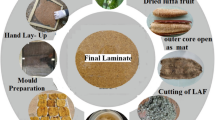Abstract
In this study, the impact and flexural properties of woven basalt fiber/phenolic (BFP), woven carbon fiber/phenolic (CFP) and woven basalt/woven carbon hybrid phenolic (BCFP) composites are investigated. The hybridization effect of woven basalt and woven carbon fibers on the impact energy absorption and flexural properties is investigated for various weight ratios of basalt/carbon hybrid fibers such as 1:0, 0.83:0.17, 0.68:0.32, 0.61:0.39, 0.34:0.66 and 0:1. It is found that the impact properties of the composites are strongly improved when the basalt fiber increased. Impact energy absorption of CFP composite showed a regular trend of increase with increasing weight ratio of basalt fiber in hybrid fiber composite. The lowest impact energy absorption values are found for the composites with weight ratio 0:1 (CFP), with average of 70 kJ/m2. Corresponding values for energy absorptions are obtained for 0.83:0.17, 0.68:0.32, 0.61:0.39, 0.34:0.66 basalt/carbon weight ratio in hybrid composites. The impact energy absorption of hybrid composites (BCFP) shows the highest value with an average of 219 kJ/m2, when the weight ratio of 0.83:0.17 is used. Finally, the impact energy absorption of BFP composites with the weight ratio of 1:0 shows the highest value of 268 kJ/m2. The experimental evidence shows that the hybrid composites based on combinations of stiff carbon fibers and tough basalt fibers have good flexural properties and therefore, they can be used as promising materials in a number of engineering sectors such as the protective structures.







Similar content being viewed by others
References
Subagia IDGA, Kim Y (2013) A study on flexural properties of carbon-basalt/epoxy hybrid composites. J Mech Sci Technol 27:987–992
Peijs AAJM, Venderbosch RW, Lemstra PJ (1990) Hybrid composites based on polyethylene and carbon fibres part 3: impact resistant structural composites through damage management. Composites 21:522–530
Swolfs Y, Gorbatikh L, Verpoest I (2013) Stress concentrations in hybrid unidirectional fiber reinforced composites with random fiber packings. Compos Sci Technol 85:10–16
Thwe MM, Liao K (2003) Durability of bamboo-glass fiber reinforced polymer matrix hybrid composites. Compos Sci Technol 63:375–387
Tjong SC, Meng YZ (1999) Properties and morphology of polyamide 6 hybrid composites containing potassium titanate whisker and liquid crystalline copolyester. Polymer 40:1109–1117
Okada O, Keskkula H, Paul DR (2000) Fracture toughness of nylon 6 blends with maleated ethylene/propylene rubbers. Polymer 41:8061–8074
Laura DM, Keskkula H, Barlow JW, Paul DR (2002) Effect of glass fiber and maleated ethylene-propylene rubber content on the impact fracture parameters of nylon 6. Polymer 43:4673–4687
Bledzki AK, Gassan J (1999) Composites reinforced with cellulose based fibers. J Program Polym Sci 24:221–274
Sreekala MS, Kumaran MG, Joseph R, Thomas S (2001) Stress-relaxation behaviour in composites based on short oil-palm fibres and phenol formaldehyde resin. Compos Sci Technol 61:1175–1188
Mishra S, Mohanty AK, Drzal LT, Misra M, Parija S, Nayak SK, Tripathy SS (2003) Studies on mechanical performance of biofiber/glass reinforced polyester hybrid composites. Compos Sci Technol 63:1377–1385
Bader MG, Ellis RM (1974) The effect of notches and specimen geometry on the pendulum impact strength of uniaxial CFRP composites. Composites 5(6):253–258
Siddeswarappa B, Mohamed Kaleemulla K (2009) Damage characteristics of fabric reinforced hybrid composite laminates subjected to low energy impacts. Int J Mater Prod Technol 34:303–311
Kim JS, Chung SK (2007) A study on the low-velocity impact response of laminates for composite railway bodyshells. Compos Struct 77:484–492
Pegoretti A, Fabbri E, Migliaresi C, Pilati F (2004) Intraply and interply hybrid composites based on E-glass and poly(vinyl alcohol) woven fabrics: tensile and impact properties. Polym Int 53:1290–1297
Sarasini F, Tirillo J, Valente M, Ferrante L, Cioffi S, Lannace S, Sorrentino L (2013) Hybrid composites based on aramid and basalt woven fabrics: impact damage modes and residual flexural properties. Mater Design 49:290–302
Naik NK, Sekher YC, Meduri S (2000) Damage in woven-fabric composites subjected to low-velocity impact. Compos Sci Technol 60:731–744
Matko S, Anna P, Marosi G, Szep A, Keszei S, Czigany T, Posloskei K (2003) Use of reactive surfactants in basalt fiber reinforced polypropylene composites. Macromol Symp 202:255–268
Ozturk S (2005) The effect of fiber content on the mechanical properties of hemp and basalt fibre reinforced phenol formaldehyde composites. J Mater Sci 40:4585–4592
Najafi M, Khalili SMR, Eslami Farsani R (2011) Thermal shock cycling effect on flexural properties of phenolic based composites reinforced by basalt and carbon fibers. Polymer Processing Society Asia/Australia Regional Meeting, Kish Island
Czigány T (2005) Basalt fiber reinforced hybrid polymer composites. Mater Sci Forum 473:59–66
Fiore V, Di Bella G, Valenza A (2011) Glass–basalt/epoxy hybrid composites for marine applications. Mater Design 32:2091–2099
Bunsell AR, Harris B (1997) Hybrid carbon and glass fibre composites. Composites 5:157–164
http://www.basaltex.com. Accessed June 2011
http://www.basaltex.com. Accessed 2012
http://www.huntsman.com. Accessed 2012
Wambua P, Ivens J, Verpoest I (2003) Natural fibres: can they replace glass in fibre reinforced plastics? Compos Sci Technol 63:1259–1264
Sreekala MS, George J, Kumaran MG, Thomas S (2002) The mechanical performance of hybrid phenol formaldehyde based composites reinforced with glass and oil-palm fibers. Compos Sci Technol 62:339–353
Coppa A, Weben CH, Mirandy L (1980) Flywheel containment technology assessment. Report No UURL. Lawrence Livermore Laboratory, Livermore, pp 152–161
Author information
Authors and Affiliations
Corresponding author
Rights and permissions
About this article
Cite this article
Najafi, M., Khalili, S.M.R. & Eslami-Farsani, R. Hybridization effect of basalt and carbon fibers on impact and flexural properties of phenolic composites. Iran Polym J 23, 767–773 (2014). https://doi.org/10.1007/s13726-014-0272-5
Received:
Accepted:
Published:
Issue Date:
DOI: https://doi.org/10.1007/s13726-014-0272-5




